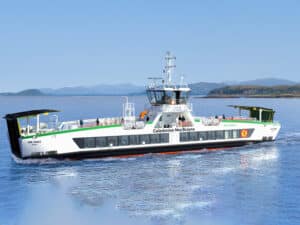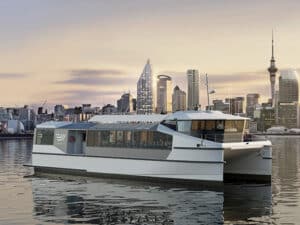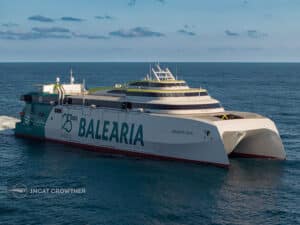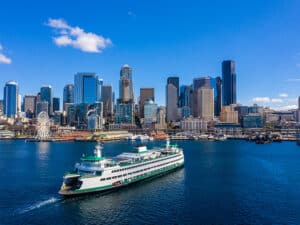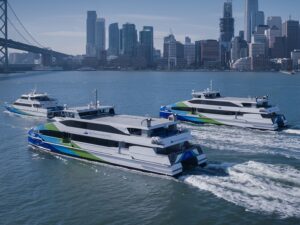
Ferry Design: The boat is just one part of the solution
Written by Heather Ervin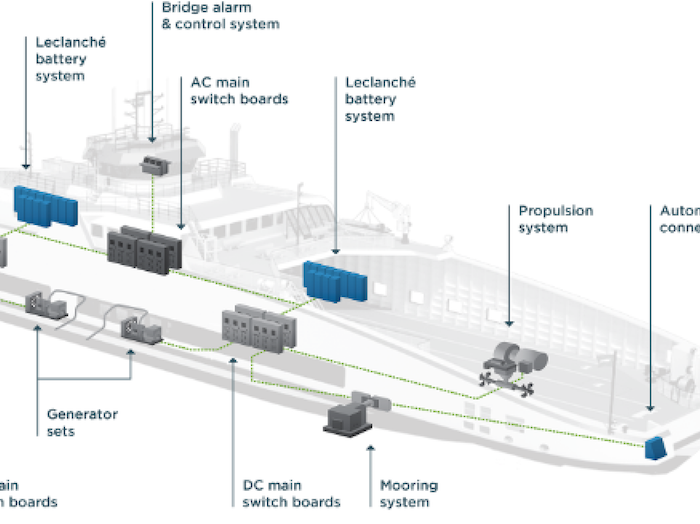
What's outside of an E-ferry is as significant as what's inside. Leclanché provided an end-to-end solution for two all-electric road ferries soon to start operation in Ontario. [Credit: Leclanché]
There are a lot of moving parts to designing a ferry system, and the boat itself is just the one that floats. Ferries—and in particular commuter ferries—are components of overall transportation networks. And in today’s world, those networks need to be green. That usually means electric. In places where electricity is already green, whether from wind, solar, hydropower or nuclear power plants, building a ferry that’s all electric from the day it enters operation is already technically feasible for increasingly long routes.
The Danish E-ferry Ellen has been operating successfully for some two years now on a route that’s 22 miles long. Though it’s not the world’s first E-Ferry (that credit goes to the Ampere in Norway, which entered service in 2015) it was built under the EU’s Horizon 2020 program which means that a lot of documentation on the project is on the public record.
In designing an all-electric ferry, a major part of the equation is the charging infrastructure and involves a significant investment. When all the pieces for an all-electric ferry are not there yet, a hybrid solution probably makes sense. What no longer makes sense is making a significant investment in a conventionally fueled vessel without designing in a pathway to future conversion/retrofit to an electric or hybrid solution.
At this point, some readers may be jumping up and down shouting “hydrogen, hydrogen” and “fuel cells.” That’s a topic for another day, but something to consider is that, at the moment, green hydrogen lies in a more distant future than green electricity.
With these thoughts in mind, let’s take a look at a few recent projects, starting with the Ellen.
Operating between the Danish islands of Ærø and Fynshav, the vessel is less than 60 meters long and with a breadth of approximately 13 meters. It ferry travels at speeds of 12-12.5 knots, and is capable of carrying 198 passengers in summer months, with this capacity dropping to 147 during winter. It can also carry 31 cars or five trucks on its open deck.
With a 4.3 MWh capacity battery pack, at the time of construction the largest installed for maritime use, it is the first electric ferry to have no emergency back-up generator on board.
Danfoss Editron was selected to supply the full electric drivetrain. The Editron system comprises two 750 kW propulsion motors and two 250 kW thruster motors, both driven by synchronous reluctance assisted permanent magnet technology and controlled by DC/AC inverters. Danfoss Editron also provided the vessel’s power management system, providing complete on-board automated power and load control. Additionally, the company delivered the onshore charging station and charging arm for the battery.
Compared to a similar modern diesel-powered ferry, Ellen annually saves around 2,520 tons of CO2, 14.3 tons of NOX, 1.5 tons of SO2, 1.8 tons of CO and half a ton of particulate matter. The E-ferry is charged from the local grid on the island of Ærø, whose electricity demand is entirely powered by wind.
Ellen delivers a propulsion system efficiency that reaches 85% grid-to-propeller. This is over twice as efficient as a conventional diesel-powered ferry (tank-to-propeller) and enabled a 20% reduction in travel time compared to the diesel-powered ferry it replaced. The E-ferry consumes around 1,600 kWh per return trip, performing better than projected in preliminary studies.
Calculations show that the initial high investment costs for building the E-ferry will be compensated for after just five to eight years of operation. These calculations take into account the charging station’s cost and the possible need for replacing the battery pack twice over the ferry’s lifetime. The quick amortization means that the operator will save between 24% and 36% in operating costs compared to operating a diesel or diesel-electric ferry for the remainder of the ferry’s estimated 30-year lifetime.
Gees Bend Ferry
While Ampere and the Ellen have captured the headlines, one all-electric ferry has been in operation in the U.S. since April 2019 when, after conversion at the Master Marine shipyard in Bayou la Batre, Ala., the historic Alabama Department of Transportation (ALDOT) Gee’s Bend ferry returned to service as America’s first zero-emission, electric-powered passenger/car ferry.
The 95-by-42-foot Gee’s Bend Ferry was originally built in 2004 with diesel propulsion. Operated by HMS Ferries on behalf of ALDOT, the 15-vehicle/132-passenger ferry runs on the Alabama River between Camden and Boykin, Ala.
The conversion was funded with the support of a $1.09 million grant from the U.S. Environmental Protection Agency, along with $765,350 matching dollars from ALDOT. Seattle, Wash., naval architecture and marine engineering firm Glosten provided concept through contract design and shipyard technical support for the project, which was managed by HMS Ferries and HMS Consulting.
Marine Interface Inc. of East Northport, N.Y., integrated the new electric propulsion system with support from American Traction Systems, Fort Myers, Fla., (power conversion) and Spear Power Systems, Grandview, Mo. (batteries). Cochran Marine, Seattle, Wash., was responsible for shipboard and shore side charging stations.
Skagit County E-Ferry
Recently, Glosten has been working on what could be the first mew build battery electric ferry in the U.S: an all-electric replacement, the 40-year-old diesel powered Guemes that operates on the 5/8 of a mile route that separates Anacortes, Wash., from Guemes Island.
The replacement ferry will be double-ended with a three-tiered deckhouse and accommodate four lanes of vehicles including highway-rated trucks and emergency vehicles. Challenges associated with mixing cars and passengers were addressed by keeping walk-on passengers and vehicles separated throughout the trip; this also improves schedule efficiency by eliminating delays during the switch between car and passenger loading. In addition, the battery-electric propulsion system will significantly reduce vessel noise production, which means that passengers can enjoy a quieter commute.
According to Glosten, the vessel will see a 50% reduction in operational costs compared to its diesel-propelled predecessor and produce virtually zero emissions during its crossing. Glosten analyzed the route, terminals, and utility infrastructure and found that charging once during each round trip was feasible, reliable, and minimized the cost of the project.
A request for proposals from electrical integrators to provide the vessel shore electrical systems and the automated charging plug for the vessel closed last month. Once the proposals have been analyzed and vendor selected the path should be open to prepare a proposal for shipyards to bid on.
Ottawa Road Ferries
Meantime, what will be the first fully electric road ferries to operate in North America have arrived in Canada from the Damen Galati shipyard in Romania. Ordered by the Ministry of Transportation, Ontario, Canada, the 68 meter long Amherst Islander II and 98 meter long Wolfe Islander IV are equipped for fully electric operation, but also have twin diesel generators installed to allow hybrid and full diesel propulsion for maximum redundancy.
The delivery of the vessels marks the completion of the first of the two stages of the project. The second stage, which is well underway, is installation of the facilities that will enable the vessels to use shore power supplied via integrated shore charging and mooring systems.
Damen has selected Switzerland-based Leclanché to construct and provide two fast charge stations, and supporting electrical storage systems on Lake Ontario. The agreement with Leclanché’s Stationary Solutions group provides the complete recharging infrastructure.
Both are powered by Leclanché’s Marine Rack System, certified by Bureau Veritas, under prior contracts with Leclanché’s e-Marine group. The Amherst Islander II (Damen 6819 E3) has a 1.9 MWh capacity Leclanché Battery system and produces zero emissions. It will carry up to 42 cars and 300 passengers at speeds of up to 12 knots and connect the mainland port city of Millhaven, Ontario, with Stella on Amherst Island. The larger Wolfe Islander IV features a 4.6 MWh Leclanché battery system and can carry twice the number of passenger vehicles as the Amherst Islander—83—plus 399 passengers. It, too, will sail at up to 12 knots.
Leclanché says that its in-house capability to provide both the battery energy storage system to power maritime vessels and the on-land charging and storage system, powered by the grid or increasingly cost-effective renewable sources of energy, sets it apart from other providers.
For those portside regions unable to install a fixed energy storage system on shore, Leclanché is working on a mobile charging station option—essentially a floating e-Barge with a fast-charge storage system onboard.
The Ontario ports and harbor systems will be equipped with a 3.0 MWh Leclanché battery energy storage system (BESS) located in port-side structures. The BESS, which will be charged by the harbor grid, is connected to the ferry charger via 1,800 kW DC-DC converters. These “buffer stations” will be protected by a fire suppression system using piped in water running alongside the battery racks and behind each battery module. The backs of each module have an opening allowing water spray to enter in the event of any thermal events. The batteries have been designed to charge each vessel up to 7,850 times per year or more than 78,500 times over their projected 10-year lifespan.
Crossing time between ports will be just 20 minutes and Leclanché’s high power, DC-to-DC fast charging system will enable the e-ferries to “refuel” in just 10 minutes at each port.

